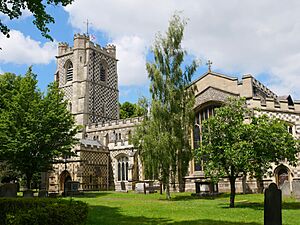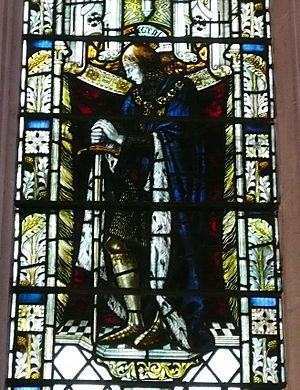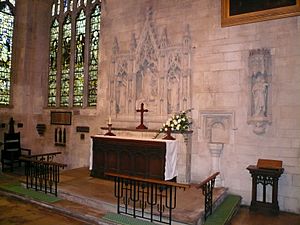St Mary's Church, Luton facts for kids
Quick facts for kids St Mary's Church |
|
|---|---|
 |
|
| Country | England |
| Denomination | Church of England |
| Previous denomination | Roman Catholic |
| Churchmanship | Broad church/Open Evangelical |
| History | |
| Status | Parish church |
| Dedication | St Mary |
| Architecture | |
| Functional status | Active |
| Specifications | |
| Number of towers | 1 |
| Bells | 12 |
| Tenor bell weight | 25cwt 0qt 24lb (1281kg) in D |
| Administration | |
| Parish | Luton |
| Deanery | Luton |
| Archdeaconry | Bedford |
| Diocese | Diocese of St Albans |
| Province | Province of Canterbury |
St Mary's Church is a very old and important church in the middle of Luton, England. It's over 900 years old! People have been fixing it up and making it better for hundreds of years.
It's one of the biggest churches in Bedfordshire and a great example of medieval building style. St Mary's is part of the St Albans Diocese. It's also a 'Grade I listed building,' which means it's super important and protected. It's the only one like it in all of Luton!
Contents
A Look Back in Time
The Very First Church
For over 1,000 years, people have gathered here to worship. A church was first built around 930 AD. King Athelstan had it built to say thank you after winning a battle against the Danes. The king owned this land a long time ago. The church was very rich back then.
Building in the 1100s
The church you see today was started in 1121 by Robert, 1st Earl of Gloucester. It was officially opened in 1137. The first church was shaped like a cross, but it didn't have side sections. As more people came, north and south side sections were added. This happened about 40 years later, around the early 1200s.
Changes in the 1300s
This was a time when the church got much bigger. A tall tower was built. The cross-shaped parts of the church were made longer. New chapels were added on the east side. A special room called a sacristy was built north of the main altar. It had a room above it. A new font was also added. It had a unique, beautifully carved stone cover.
Updates in the 1400s

Lots of repair and rebuilding work happened during this time. The Someries chapel was made bigger. The sacristy was rebuilt further east. The west tower was made taller, and most of its windows were replaced. All this work was possible thanks to Lord John Wenlock. His family had been connected to the church since 1389. In 1461, a chapel was renamed the Wenlock Chapel. William Wenlock, John's father, is buried there.
Besides the Wenlock Chapel, there are other special areas. These include the Hoo Chapel, the Rotheram family monuments, and the Barnard Chantry chapel.
The 1800s and 1900s
More restoration work began in the 1800s. This helped make the church look its best again. The special pattern of flint and stone squares was added to most of the church. The tower was repaired in 1906. The Wenlock Chapel was also restored in 1914.
In the 1960s, new offices, halls, and vestries were built. They matched the stone pattern and gave the church more space. A beautiful window called the Magnificat Window was put in the south transept in 1979. More recently, projection screens were added. The pulpit was moved back to its old spot. The old heating system was completely replaced in 2019.
Helping Hands: The Friends of St Mary's
A lot of money for the church's building has come from the Friends of St Mary's Luton. They have raised over £1 million since 1965.
The Church Clock
The church clock was put in place in 1901. It faced west, looking over the town. It was a special clock that chimed every quarter hour. It was built by J.W. Benson and cost £200. The quarter chimes rang on four different bells. The hours were struck on the largest bell, which weighed about 17 cwt.
The clock was fixed up in 1909 and 1949. A new bell was even added. But in 1979, the clock stopped working. Its bells were silent for 28 years. Then, the University of Bedfordshire offered to help. They owned buildings near the church. They wanted to fix the clock for the new year and the millennium. The clock was officially started again on November 11, 1999, which is Armistice Day.
St Mary's Today
Today, St Mary's follows the Open Evangelical tradition of the Church of England. It is well-known for its work with young people in Luton. It also has a special peace and reconciliation ministry.
The area next to St Mary's Church, called Power Court, has been planned for new buildings for years. Luton Town Football Club wants to build a stadium and other facilities there. This project has been approved and is expected to be finished in the future.
Church Design
The design of St Mary's is quite varied. This is because the church has been repaired and rebuilt many times. However, its basic shape is like a cross. It has side sections running north and south. There are also many chapels and extra parts branching off the main church.
The church is about 53 meters (174 feet) long. It is about 17 meters (56 feet) wide. The height of the church is about 27 meters (89 feet). The outside of the church has a unique pattern. It's made of flint and stone squares. This makes the church really stand out in the town.
The old graveyard right next to the church is no longer used. However, there is a larger cemetery. It covers most of St Anne's hill. This cemetery, called Luton Church Cemetery, is about a mile from the church. It's located up towards Crawley Green.


